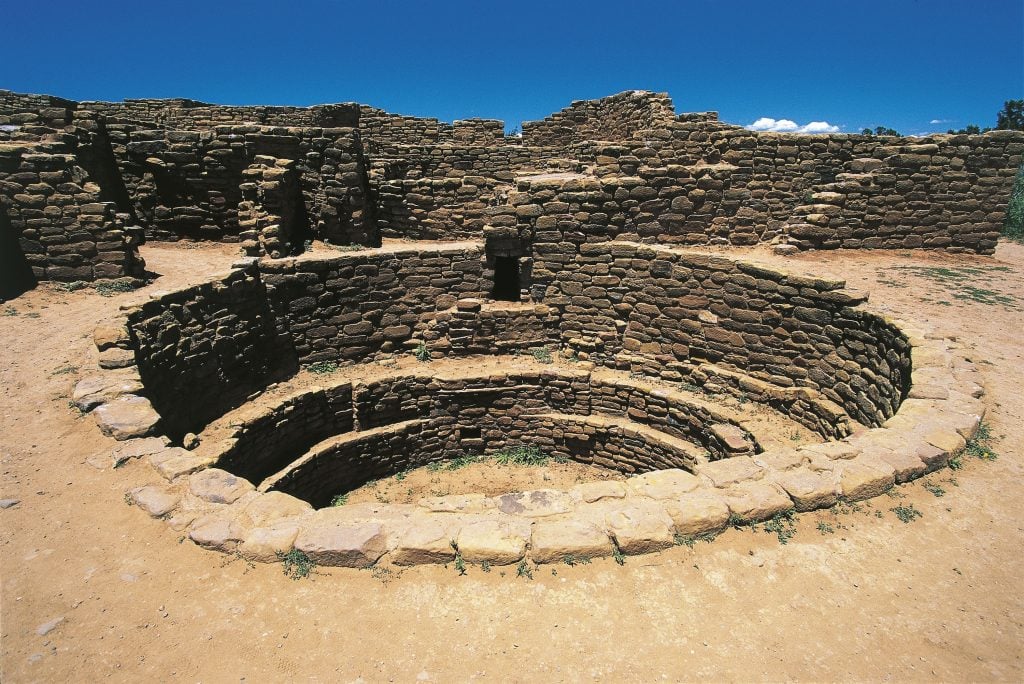Kiva at Cliff Palace in Mesa Verde National Park. Photo: Nik Wheeler/ Getty Images.
Dry air coupled with the site’s protection from the elements have preserved a rich archaeological record. Kivas, semi-underground rooms serving ceremonial and social functions, exhibit the work of skilled masons. Elaborate symbolic paintings in crimson, charcoal, and tortoise touch the walls. It’s estimated Cliff Palace housed 250 people and scenes of everyday life are conjured in yucca leaf sandals, wooden game instruments, and animal bones used to imitate the call of birds.

A mural inside a house at Cliff Palace. Photo: courtesy NPS.
Cliff Palace is a stark, though fascinating, outlier. Of the roughly 15,000 peoples who once worked the rugged landscape, the overwhelming majority lived in settlements on canyon bottoms and mesa tops, hill summits made fertile by windblown silt. Their descendants had crossed the Bering land bridge during the last Ice Age, gradually spreading across coastal North America before moving inland. Those who arrived in the mid-500s spread out across an area now encompassed by parts of Colorado, Utah, New Mexico, and Arizona. At first, they lived in mud-roofed pit houses before settling on an architecture with both above and below ground areas. The cliff dwellings only begin in the final 75 years of the 6th century.

Corn grinding stones found in Cliff Palace, Mesa Verde. Photo: Planet One Images/Universal Images Group via Getty Images.
This raises two essential questions when Cliff Palace was rediscovered in 1888: Why did the ancestral Puebloans move into cliff dwellings and what caused them to abandon the land at the end of the 13th century? In both cases, water played a dominant role.
Tree ring analysis has revealed two mega droughts hit the area, the first in the mid-1100s and the second from 1276 to 1300. Across the landscape, villages moved closer to the wetter areas around canyon rims. The cliff dwellings follow this trend, allowing people to access seep springs and water runoff. Cooler in summer and warmer in winter, cliff dwellings offered environmental advantages including easy access to the farmable mesa tops and ready spaces to store food away from pests. Some archaeologists have inferred water shortages increased regional conflict with the cliff dwellings, often accessible only by ladder, providing strong defensive positions.

The ruins at Far View, one of the larger canyon villages. Photo by De Agostini/ Getty Images.
Drought was long cited as the only factor prompting the abandonment; now anthropologists suggest it was simply the final blow. After all, the inhabitants were experts at producing their stables of corn, beans, squash from a limited supply of water. One idea is that the hierarchical structure of society broke down. Previously, elites had been entrusted with ensuring fruitful harvests and as they failed, people began reorganizing themselves, as evidenced by the large villages centered on communal spaces, rather than elite class houses, that emerged in the mid-1100s. As the second drought deepened in the late 1200s, these people were free to set off in search of more agreeable land.
Today, many of these canyon settlements making up the largest cliff dwelling in North America are little more than depressions in the ground, piles of earth and stone. All the same, they tell an equally cautionary tale about food security and the capricious whims of mother nature.
Follow Artnet News on Facebook:
Want to stay ahead of the art world? Subscribe to our newsletter to get the breaking news, eye-opening interviews, and incisive critical takes that drive the conversation forward.
Source link : http://www.bing.com/news/apiclick.aspx?ref=FexRss&aid=&tid=66b8d7b930654a1f8614da95f831774b&url=https%3A%2F%2Fnews.artnet.com%2Fart-world%2Fhuge-cliff-palace-mesa-verde-2522452&c=432062416884869371&mkt=en-us
Author :
Publish date : 2024-08-11 04:04:00
Copyright for syndicated content belongs to the linked Source.












